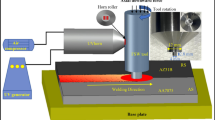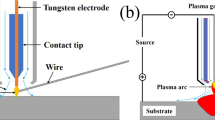Abstract
In the present paper, the evolutions of material flow and intermetallic compounds (IMCs) during friction stir welding (FSW) of dissimilar Al/Cu with two different plate positions are analyzed to elucidate the correlations with mechanical properties of the joints. Under the tool rotation speed of 700 rpm and the welding speed of 110 mm/min, the Al or Cu plate is located at the advancing side (AS) and the retreating side (RS), which are marked as Al-AS/Cu-RS and Al-RS/Cu-AS, respectively. The results demonstrate that material flow plays a significant role on both the formation and the distribution features of IMCs during FSW with different plate positions. For Al-AS/Cu-RS, the dissimilar material was deposited immediately behind the tool without being drawn into the pin rotating, so that a regular two-layer IMCs within a thickness of 1.5 μm are formed throughout the Al/Cu bonding interface. For Al-RS/Cu-AS, the dissimilar material is sticking with the tool and rotating for multiple circles before it is finally deposited, both two-layer and three-layer IMCs are observed with the thickness ranging from 0.5 to 4.0 μm at the Al/Cu bonding interface, and a multitude of IMCs are also formed in the intermixing zone, which are both confirmed to be detrimental to the joint mechanical performance. Therefore, the ultimate tensile strength of the Al/Cu joint improves by over 20% with changing the position of Cu plate from the AS to the RS in FSW.
Graphical Abstract



















Similar content being viewed by others
References
Sadeghian A, Iqbal N (2022) A review on dissimilar laser welding of steel-copper, steel-aluminum, aluminum-copper, and steel-nickel for electric vehicle battery manufacturing. Opt Laser Technol 146:107595
Meng X, Huang Y, Cao J, Shen J, dos Santos JF (2021) Recent progress on control strategies for inherent issues in friction stir welding. Prog Mater Sci 115:100706
DebRoy T, Bhadeshia HKDH (2010) Friction stir welding of dissimilar alloys – a perspective. Sci Technol Weld Join 15:266–270
Simar A, Avettand-Fènoël MN (2017) State of the art about dissimilar metal friction stir welding. Sci Technol Weld Join 22:389–403
Mishra RS, Ma ZY (2005) Friction stir welding and processing. Mat Sci Eng R 50:1–78
Eheliyagoda D, Wei F, Shan G, Albalghiti E, Zeng X, Li J (2019) Examining the temporal demand and sustainability of copper in China. Environ Sci Technol 53:13812–13821
Mathivanan K, Plapper P (2021) Correlation of optical signal during laser fusion welding of copper to aluminum. J Laser Appl 33:012037
Fan D, Yang N, Huang J, Yu X (2021) Plasma arc welding-brazing of aluminum to copper with SiO2 nanoparticles strengthening. J Manuf Process 69:253–260
Galvão I, Loureiro A, Rodrigues DM (2016) Critical review on friction stir welding of aluminium to copper. Sci Technol Weld Join 21:523–546
Mehta KP, Badheka VJ (2016) A review on dissimilar friction stir welding of copper to aluminum: process, properties, and variants. Mater Manuf Process 31:233–254
Sharma N, Khan Z, Siddiquee AN (2017) Friction stir welding of aluminum to copper - an overview. T Nonferr Metal Soc 27:2113–2136
Ouyang J, Yarrapareddy E, Kovacevic R (2006) Microstructural evolution in the friction stir welded 6061 aluminum alloy (T6-temper condition) to copper. J Mater Process Tech 172:110–122
Galvão I, Loureiro A, Verdera D, Gesto D, Rodrigues DM (2012) Influence of tool offsetting on the structure and morphology of dissimilar aluminum to copper friction-stir welds. Metall Mater Trans A 43A:5096–5105
Avettand-Fènoël MN, Taillard R, Ji G, Goran D (2012) Multiscale study of interfacial intermetallic compounds in a dissimilar Al 6082–T6/Cu friction-stir weld. Metall Mater Trans A 43A:4655–4666
Muthu MFX, Jayabalan V (2015) Tool travel speed effects on the microstructure of friction stir welded aluminum–copper joints. J Mater Process Tech 217:105–113
Xue P, Xiao BL, Ni DR, Ma ZY (2010) Enhanced mechanical properties of friction stir welded dissimilar Al–Cu joint by intermetallic compounds. Mat Sci Eng A-struct 527:5723–5727
Xue P, Ni DR, Wang D, Xiao BL, Ma ZY (2011) Effect of friction stir welding parameters on the microstructure and mechanical properties of the dissimilar Al–Cu joints. Mat Sci Eng A-struct 528:4683–4689
Karrar G, Galloway A, Toumpis A, Li H, Al-Badour F (2020) Microstructural characterisation and mechanical properties of dissimilar AA5083-copper joints produced by friction stir welding. J Mater Res Technol 9:11968–11979
Mao Y, Ni Y, Xiao X, Qin D, Fu L (2020) Microstructural characterization and mechanical properties of micro friction stir welded dissimilar Al/Cu ultra-thin sheets. J Manuf Process 60:356–365
Hou W, Shah LHA, Huang G, Shen Y, Gerlich A (2020) The role of tool offset on the microstructure and mechanical properties of Al/Cu friction stir welded joints. J Alloy Compd 825:154045
Mehta KP, Badheka VJ (2017) Hybrid approaches of assisted heating and cooling for friction stir welding of copper to aluminum joints. J Mater Process Tech 239:336–345
Fei X, Ye Y, Jin L, Wang H, Lv S (2018) Special welding parameters study on Cu/Al joint in laser-heated friction stir welding. J Mater Process Tech 56:160–171
Yaduwanshi DK, Bag S, Pal S (2016) Numerical modeling and experimental investigation on plasma-assisted hybrid friction stir welding of dissimilar materials. Mater Des 92:166–183
Muhammad NA, Wu CS, Tian W (2019) Effect of ultrasonic vibration on the intermetallic compound layer formation in Al/Cu friction stir weld joints. J Alloy Compd 785:512–522
Muhammad NA, Wu CS (2020) Evaluation of capabilities of ultrasonic vibration on the surface, electrical and mechanical behaviours of aluminium to copper dissimilar friction stir welds. Int J Mech Sci 183:105784
Zhao Y, You J, Qin J, Dong C, Liu L, Liu Z, Miao S (2022) Stationary shoulder friction stir welding of Al–Cu dissimilar materials and its mechanism for improving the microstructures and mechanical properties of joint. Mat Sci Eng A-struct 837:142754
You J, Zhao Y, Dong C, Miao S, Liu Z, Liu L, Su Y (2022) Microstructural evolution and mechanical properties of the Al–Cu dissimilar joint enhanced by stationary-dynamic shoulder friction stir welding. J Mater Process Tech 300:117402
Tian W, Su H, Wu C (2020) Effect of ultrasonic vibration on thermal and material flow behavior, microstructure and mechanical properties of friction stir welded Al/Cu joints. Int J Adv Manuf Tech 107:59–71
Su H, Wu CS, Pittner A, Rethmeier M (2013) Simultaneous measurement of tool torque, traverse force and axial force in friction stir welding. J Manuf Process 15:495–500
Zhai M, Wu CS, Su H (2020) Influence of tool tilt angle on heat transfer and material flow in friction stir welding. J Manuf Process 59:98–112
Su H, Zhao Q, Chen J, Wu C (2022) Homogenizing the intermetallic compounds distribution in Al/Cu dissimilar friction stir welding joint with the assistance of ultrasonic vibration. Mater Today Commun 31:103643
Nandan R, DebRoy T, Bhadeshia HKDH (2008) Recent advances in friction-stir welding – process, weldment structure and properties. Prog Mater Sci 53:980–1023
Funamizu Y, Watanabe K (1971) Interdiffusion in the Al-Cu system. J Jpn I Met 12:147–152
Zobac O, Kroupa A, Zemanova A, Richter KW (2019) Experimental description of the Al-Cu binary phase diagram. Metall Mater Trans A 50A:3805–3815
Shah LH, Walbridge S, Gerlich A (2019) Tool eccentricity in friction stir welding: a comprehensive review. Sci Technol Weld Join 24:566–578
Su H, Chen J, Wu C (2022) Effect of tool eccentricity on the periodic material flow in friction stir welding process. Int J Mech Sci 220:107164
Zhou L, Li GH, Zhang RX, Zhou WL, He WX, Huang YX, Song XG (2019) Microstructure evolution and mechanical properties of friction stir spot welded dissimilar aluminum-copper joint. J Alloy Compd 775:372–382
Moisy F, Sauvage X, Hug E (2020) Investigation of the early stage of reactive interdiffusion in the Cu-Al system by in-situ transmission electron microscopy. Mater 9:100633
Xu H, Liu C, Silberschmidt VV, Pramana SS, White TJ, Chen Z, Acoff VL (2011) Behavior of aluminum oxide, intermetallics and voids in Cu–Al wire bonds. Acta Mater 59:5661–5673
Gueydan A, Domenges B, Hug E (2014) Study of the intermetallic growth in copper-clad aluminum wires after thermal aging. Intermetallics 50:34–42
Xu H, Qin I, Clauberg H, Chylak B, Acoff VL (2016) New observation of nanoscale interfacial evolution in micro Cu–Al wire bonds by in-situ high resolution TEM study. Scripta Mater 115:1–5
Acknowledgments
The authors are grateful to the financial support from the National Natural Science Foundation of China (Grant No. 52005297).
Author information
Authors and Affiliations
Contributions
HS contributed to conceptualization, methodology, software, writing—original draft, writing—review and editing, project administration, funding acquisition. QZ contributed to data curation; methodology, validation. JC contributed to supervision. CW contributed to writing—review and editing, supervision.
Corresponding author
Ethics declarations
Competing interest
The authors declare that they have no known competing financial interests or personal relationships that could have appeared to influence the work reported in this paper.
Additional information
Handling Editor: Megumi Kawasaki.
Publisher's Note
Springer Nature remains neutral with regard to jurisdictional claims in published maps and institutional affiliations.
Rights and permissions
Springer Nature or its licensor (e.g. a society or other partner) holds exclusive rights to this article under a publishing agreement with the author(s) or other rightsholder(s); author self-archiving of the accepted manuscript version of this article is solely governed by the terms of such publishing agreement and applicable law.
About this article
Cite this article
Su, H., Zhao, Q., Chen, J. et al. Evolutions of material flow and intermetallic compounds, and the correlations with mechanical properties of dissimilar Al/Cu friction stir welding joints. J Mater Sci 57, 20485–20502 (2022). https://doi.org/10.1007/s10853-022-07879-1
Received:
Accepted:
Published:
Issue Date:
DOI: https://doi.org/10.1007/s10853-022-07879-1




